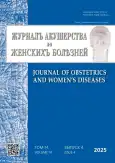Experience of using ovarian stimulation protocol with dienogest in patients with infertility and endometriosis
- Authors: Gorelova I.V.1,2, Makolkin A.A.1, Polyakova L.I.2, Chernoshtan K.V.1, Mosyagin V.B.3, Arnt O.S.1,3, Efimova A.A.2
-
Affiliations:
- Delta Fertility Clinic
- Almazov National Medical Research Centre
- Saint Petersburg State Pediatric Medical University
- Issue: Vol 74, No 4 (2025)
- Pages: 5-13
- Section: Original study articles
- Submitted: 28.04.2025
- Accepted: 08.07.2025
- Published: 26.08.2025
- URL: https://journals.eco-vector.com/jowd/article/view/678936
- DOI: https://doi.org/10.17816/JOWD678936
- EDN: https://elibrary.ru/RCCNPQ
- ID: 678936
Cite item
Abstract
BACKGROUND: Endometriosis is most often characterized by two main clinical symptoms, namely, pelvic pain and infertility. Hormonal therapy may be prescribed to reduce the recurrence of the disease after surgical treatment and to relieve pain. It in most cases is incompatible with pregnancy planning and infertility treatment in in vitro fertilization programs. Currently, a protocol with various gestagens has been described for ovarian stimulation applicable in programs with cryopreservation of all embryos. However, there is scarce data on the use of such a protocol with dienogest that is widely used in the treatment of endometriosis.
AIM: The aim of this study was to assess the effectiveness and safety of using a protocol of assisted reproductive technology with dienogest in patients with endometriosis and infertility.
METHODS: This retrospective single-center cohort study included patients aged 18 to 45 years with infertility and endometriosis confirmed by surgical treatment or imaging methods (magnetic resonance imaging and ultrasound). The included couples underwent cycles of assisted reproductive technology with ovarian stimulation: with dienogest 2 mg/day continuously, with gonadotropin-releasing hormone agonists, and with gonadotropin-releasing hormone antagonists. All obtained blastocysts were cryopreserved by vitrification. Transfer of thawed embryos was performed in a modified natural cycle or with hormone replacement therapy. We assessed the frequency of obtaining embryos suitable for cryopreservation and euploid (according to the results of preimplantation genetic testing), as well as the frequency of pregnancy and its outcome. When assessing safety, side effects of the drugs used and the frequency of complications were monitored.
RESULTS: 49 couples underwent 80 cycles of assisted reproductive technology with ovarian stimulation: dienogest was used in group 1 (n = 29); protocol with gonadotropin-releasing hormone agonists in group 2 (n = 9); and protocol with gonadotropin-releasing hormone antagonists in group 3 (n = 42). All obtained blastocysts were cryopreserved by vitrification (162 embryos in total). The average age of the patients was 37.99 ± 4.50 years. In group 3, women more often reported local adverse reactions after the introduction of gonadotropin-releasing hormone antagonists (p = 0.021). The study groups did not differ in the frequency of other adverse reactions such as abdominal pain, gastrointestinal symptoms, and headache (p = 0.823). The results of ovarian stimulation were comparable between all the study groups. In total, 31 embryo transfers were performed. The clinical pregnancy rate was 35.5% (95% confidence interval 19.2–54.6): 75.0% in group 1, 33.3% in group 2, and 20.0% in group 3 (p = 0.023). No differences were found in the analysis of pregnancy outcomes between the study groups (p = 0.118). The groups did not differ in the frequency of preimplantation genetic testing (p = 0.153) and embryo quality (p = 0.82).
CONCLUSION: The ovarian stimulation protocol with dienogest allows for effective treatment of infertility in patients with endometriosis without discontinuing drug therapy for a long time.
Full Text
About the authors
Inga V. Gorelova
Delta Fertility Clinic; Almazov National Medical Research Centre
Author for correspondence.
Email: ingavgorelova@gmail.com
ORCID iD: 0000-0002-6098-1491
SPIN-code: 1207-5705
MD, Cand. Sci. (Medicine), Assistant Professor
Russian Federation, Saint Petersburg; Saint PetersburgAleksandr A. Makolkin
Delta Fertility Clinic
Email: amakolkin@df.clinic
ORCID iD: 0000-0001-8858-7333
MD
Russian Federation, Saint PetersburgLada Igorevna Polyakova
Almazov National Medical Research Centre
Email: polyakova.lada.2002@gmail.com
Russian Federation, Saint Petersburg
Ksenia V. Chernoshtan
Delta Fertility Clinic
Email: kchernoshtan@df.clinic
MD
Russian Federation, Saint PetersburgVadim B. Mosyagin
Saint Petersburg State Pediatric Medical University
Email: vbmosyagin@gmail.com
SPIN-code: 2169-8330
MD, Dr. Sci. (Medicine), Professor
Russian Federation, Saint PetersburgOlga S. Arnt
Delta Fertility Clinic; Saint Petersburg State Pediatric Medical University
Email: oarnt@df.clinic
ORCID iD: 0000-0003-1565-2012
SPIN-code: 1482-0917
MD, Cand. Sci. (Medicine), Assistant Professor
Russian Federation, Saint Petersburg; Saint PetersburgAlena A. Efimova
Almazov National Medical Research Centre
Email: alyona-sokolova@mail.ru
ORCID iD: 0000-0003-3323-1561
SPIN-code: 2423-0370
MD
Russian Federation, Saint PetersburgReferences
- Endometriosis. Clinical guidelines of the Russian Society of Obstetricians and Gynecologists, 2024 [Internet]. [Updated 2024 Sep 25; cited 2025 Jan 9]. Available from: https://drive.google.com/file/d/14XuaZzgwocmmXOXVzeVT60QK4WokgbpH/view. (In Russ).
- Prescott J, Farland LV, Tobias DK, et al. A prospective cohort study of endometriosis and subsequent risk of infertility. Hum Reprod. 2016;31(7):1475–1482. doi: 10.1093/humrep/dew085
- Ceccaroni M, Bounous VE, Clarizia R, et al Recurrent endometriosis: a battle against an unknown enemy. Eur J Contracept Reprod Health Care. 2019;24(6):464–474. EDN: DPHPAL doi: 10.1080/13625187.2019.1662391
- European Society of Human Reproduction and Embryology. Endometriosis. 2022. [cited 2025 Jan 9]. Available from: https://www.eshre.eu/Guideline/Endometriosis
- Somigliana E, Viganò P, Benaglia L, et al. Ovarian stimulation and endometriosis progression or recurrence: a systematic review. Reprod Biomed Online. 2019;38(2):185–194. doi: 10.1016/j.rbmo.2018.11.021
- Female infertility. Clinical guidelines of the Russian Society of Obstetricians and Gynecologists, 2024 [Internet]. [Updated 2024 Jul 20; cited 2025 Jan 25]. Available from: https://drive.google.com/file/d/1hqRk0UpteIvoUSommkSMyhnXFfSg-jyt/view. (In Russ).
- Bosch E, Broer S, Griesinger G, et al. ESHRE guideline: ovarian stimulation for IVF/ICSI. Hum Reprod Open. 2020;2020(2):hoaa009. EDN: CBCDVP doi: 10.1093/hropen/hoaa009
- Iwami N, Kawamata M, Ozawa N, et al. New treatment strategy for endometriosis using progestin-primed ovarian stimulation with dienogest: a prospective cohort study, comparison of dienogest versus dydrogesterone. Reprod Biol. 2021;21(1):100470. EDN: RSIIEM doi: 10.1016/j.repbio.2020.100470
- Mathieu D’Argent E, Ferrier C, Zacharopoulou C, et al. Outcomes of fertility preservation in women with endometriosis: comparison of progestin-primed ovarian stimulation versus antagonist protocols. J Ovarian Res. 2020;13(1):18. EDN: FZTUDU doi: 10.1186/s13048-020-00620-z
- Somigliana E, Li Piani L, Paffoni A, et al. Endometriosis and IVF treatment outcomes: unpacking the process. Reprod Biol Endocrinol. 2023;21(1):107. EDN: PAMEUE doi: 10.1186/s12958-023-01157-8
Supplementary files









